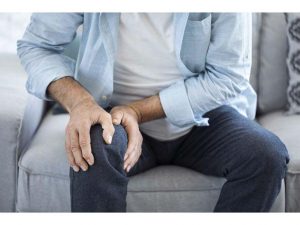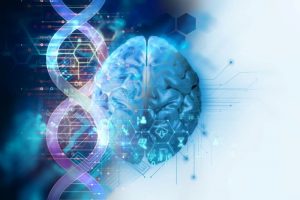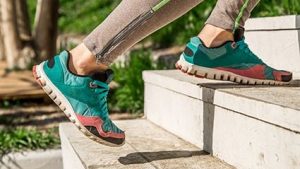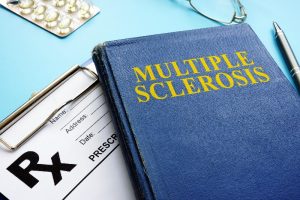(HealthDay News) — From a car accident to a sports mishap, any incident that snaps the head forward and backward can trigger whiplash. Hallmarks of whiplash include pain, decreased range of motion and stiff neck. Because the injury can’t always be seen in imaging tests, symptoms are the primary way to identify whiplash, says Cleveland Clinic. To treat whiplash, you can perform stretching exercises three-to-four times a day. Cleveland Clinic suggests that you rotate the neck from side to side, tilt the head from side to side, move the neck forward toward the chest and backward, and roll the shoulders in circles. Cleveland Clinic also recommends applying ice to the area to loosen tight muscles. If there’s significant pain, visit a doctor.
All Health/Fitness:
Health Tip: Living With a Herniated Disc
(HealthDay News) — A herniated disc is a spinal injury that can be caused by excessive strain, says the American Association of Neurological Surgeons. Symptoms of a herniated disc can range from a soft back ache to extreme pain or numbness. After diagnosis, doctors usually recommend that patients maintain a low, painless activity level for a few days or weeks. For mild-to-moderate pain, patients can use anti-inflammatory medication and physical therapy. Physical therapy may entail ice and heat therapy, electrical muscle stimulation and stretching exercises. For a herniated diss that causes severe pain, a doctor may recommend surgery.
Health Tip: Treating Whiplash
(HealthDay News) — From a car accident to a sports mishap, any incident that snaps the head forward and backward can trigger whiplash. Hallmarks of whiplash include pain, decreased range of motion and stiff neck. Because the injury can’t always be seen in imaging tests, symptoms are the primary way to identify whiplash, says Cleveland Clinic. To treat whiplash, you can perform stretching exercises three-to-four times a day. Cleveland Clinic suggests that you rotate the neck from side to side, tilt the head from side to side, move the neck forward toward the chest and backward, and roll the shoulders in circles. Cleveland Clinic also recommends applying ice to the area to loosen tight muscles. If there’s significant pain, visit a doctor.
Health Tip: Living With a Herniated Disc
(HealthDay News) — A herniated disc is a spinal injury that can be caused by excessive strain, says the American Association of Neurological Surgeons. Symptoms of a herniated disc can range from a soft back ache to extreme pain or numbness. After diagnosis, doctors usually recommend that patients maintain a low, painless activity level for a few days or weeks. For mild-to-moderate pain, patients can use anti-inflammatory medication and physical therapy. Physical therapy may entail ice and heat therapy, electrical muscle stimulation and stretching exercises. For a herniated diss that causes severe pain, a doctor may recommend surgery.
Got High Blood Pressure? Get Your Flu Shot

If you have high blood pressure, getting a flu shot could save your life, researchers say. A new study found that patients with high blood pressure who got a flu shot had a nearly 18% lower risk of dying during flu season. Previous research has found that the stress flu puts on the body may trigger heart attacks and strokes. Patients with high blood pressure already are at increased risk for both. For the study, researchers analyzed data from Denmark on more than 608,000 people, aged 18 to 100, with high blood pressure during nine flu seasons, from 2007 to 2016. The investigators looked at how many patients got a flu shot before each flu season and how many died. After adjusting for patient characteristics — such as age, health problems and medications — in a given flu season, flu vaccination was associated with an 18% lower risk of death from any cause; a 16% lower risk of death from any cardiovascular cause; and a 10% lower risk of death from heart attack or stroke. The findings were to be presented Sunday at the annual meeting of the European Society of Cardiology (ESC), in Paris. Research presented at meetings is typically considered preliminary until published in a peer-reviewed journal. “Given these results, it is my belief that all patients with high blood pressure should have… read on >
Getting Hitched Might Lower Your Odds for Dementia

Marriage has been said to deflect depression, stave off stress, even help people live longer. Now a new study says it may also decrease your chance of developing dementia. Dementia is a general term for a decline in mental ability severe enough to interfere with daily life. Married people have a far lower chance of being diagnosed with this dreaded disorder than those who are divorced or separated, widowed, or never married, according to the study. And marriage is more protective than cohabitation, the study revealed. Divorced people have more than twice the odds for mental decline compared to married folks, the 14-year study found. And divorced men have it worse: They have a 2.6 times higher chance of developing dementia than married men, while divorced women have a 30% increased risk versus married women. “There are a lot of theories about why marriage might be good for general health,” says Hui Liu, lead investigator and professor of sociology at Michigan State University. “Married people, of course, are financially better off than those who do not have a spouse,” she said. “But there are factors other than economics that play just as strongly into this. There’s the social psychology benefit.” While the study only found an association rather than a cause-and-effect link, it noted that divorce can lead to financial and emotional stress, which may… read on >
For NFL Players, Career Length, Role Affect Future Health Risks: Study

Pro football players who had long careers at key positions are more likely to have concussion-related problems such as confusion, memory loss, depression and anxiety, a new study finds. In a survey of nearly 3,500 former NFL players (average age 53), 1 in 8 (12%) reported serious cognitive problems. That compares to about 2% of the general U.S. population. Age didn’t appear to be a factor. Former players younger than 52 had a rate (13%) of problems similar to that of other ex-players. Even those 45 and younger had an increased risk. In fact, 30% of those 45 and younger who suffered the most serious concussions had severe problems with thinking and mental health, the study found. Those who played 10 or more seasons were twice as likely to have severe problems than those who played just one season (12.6% versus 5.8%). The risk rose with each season played, and every five seasons of play was associated with a nearly 20% increase in risk. Kickers, punters and quarterbacks had the fewest concussion symptoms per season, followed by wide receivers, defensive backs, linemen and tight ends. Running backs, linebackers and special teams players had the most. The risk of serious problems was twice as high among former players with the most concussion symptoms (15%) than in those with the fewest (6%). Those with the most concussions… read on >
Your Fall Game Plan to Avoid Weight Gain

When summer fruits and vegetables start to disappear from grocery stores, and the action shifts indoors to watching sports and munching on unhealthy snacks, it helps to have a diet plan in place to avoid weight gain. First, remember that farmers’ markets are still open across the country. You can buy local as long as you make the shift from summer crops to fall ones. That means tomatoes and cucumbers give way to offerings like root vegetables, including carrots, parsnips and turnips, and the wide variety of squashes such as acorn, butternut, Hubbard and kabocha. These are all great for hearty, cook-ahead soups and stews for dinners and brown bag lunches. Vegetables in the orange family, including sweet potatoes, are rich in vitamin A. But don’t overlook nutrient-dense dark, leafy greens like varieties of chard and bok choy. Brussels sprouts, cauliflower, broccoli and other cruciferous vegetables may be abundant in your area, and they taste great roasted with a slight drizzle of olive oil and finished with a splash of balsamic vinegar — hearty enough for a vegetarian meal. Though local melons, stone fruits and many berries may be gone, explore sweet fall fruits like apples, pears and grapes, as well as the more exotic pomegranates, persimmons and quince, the season’s first cranberries and even fall raspberries. Have fruit salads ready to snack on instead… read on >
E-Scooters Plus Drinking: A Fast-Pass to the ER?

Drinking and driving an electric scooter doesn’t mix, according to a new study. Researchers reported serious injuries like brain bleeding or fractures that have happened while riding an electric scooter (e-scooter). Alcohol and drugs were a factor in many of these crashes. “E-scooters may look like fun and games, but it’s a vehicle. It’s a motor attached to wheels, and you need to have a healthy respect for it. Anyone drinking or using any mind-altering substance should not be operating an e-scooter,” said the study’s lead author Dr. Leslie Kobayashi. She’s an associate professor of clinical surgery at the University of California, San Diego. Several people have died while riding e-scooters, according to published reports. Though these devices aren’t new, their popularity soared when several companies introduced rentable, dockless e-scooters in 2017, according to the study authors. Less than a year after the introduction of this environmentally friendly mode of transportation, almost 4% of U.S. adults said they had ridden one. E-scooters are available in more than 65 cities, the study said. The laws regulating them vary depending on where you’re riding. In California, drivers over age 18 aren’t required to wear helmets, and they can use e-scooters on roads with speed limits up to 35 mph. Kobayashi’s study found that almost none of the injured riders was wearing a helmet. She said anytime you’re… read on >
Health Tip: Treating a Jammed Finger
(HealthDay News) — A jammed finger can be a small fracture, dislocation or a sprain to one of the joints, says Mayo Clinic. The injury can be painful and the joint can swell. To treat a jammed finger, Mayo suggests: Ice the finger with a cold pack for up to 15 minutes. Elevate the hand to reduce swelling. Tape the injured finger to an adjacent finger. Seek prompt medical care if the finger appears deformed, if the injured person develops a fever or if the finger becomes numb.




























